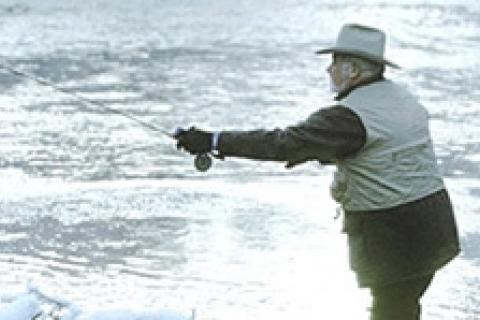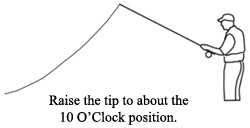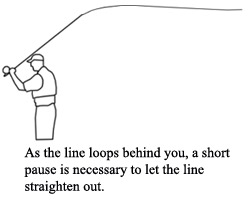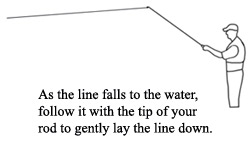
The single most important aspect to fly fishing is the ability to accurately present flies to feeding fish in a matter of a few second's time without spooking fish from repeated false casting or noisy splash-downs. Learning the fundamentals of a proper overhead cast is very important to beginning fly fisherman because these casting ground-rules are what fly anglers will need to accomplish more advanced casting presentations such as roll casting and shooting or hauling line.
 |
 |
 |
 |
 |
 |
For most beginning fly casters, watching an experienced caster loop 40 to 50 feet or line repeatedly can be more than intimidating. Truthfully, a lot fish are caught by anglers between 10 to 30 feet, so learning the basics of short distance casting is very important for anglers. At first attempt the overhead cast will feel difficult to perform, but with repeated practice and a few pointers your casting stroke will become smooth and powerful enough to deliver flies to fish even in the toughest of conditions.
The overhead fly cast can be broken down into two main phases, the back cast and the front cast. To begin the casting stroke the back cast is the first skill needed to get the line off of the water and into the air. A general rule to follow is that the back cast dictates how good the front cast is going to be. Meaning if things are going bad at the start of the cast there are probably not going to get better so you should dump the line and restart. There are many different ways to do it, but this is how I learned.
Start Position
First off you want to set yourself up in an open area with lots of room and free of obstructions above eye level. Nothing can be worse for confidence then getting a new fly line wrapped up in a telephone or power line. Pick a comfortable position for your body with your feet approximately shoulder width apart (if you are right handed then your right foot should be slightly ahead of you left foot).
Start the rod tip touching the ground in front of your body with approximately 10 to 15 feet of line spooled out of your rod tip lying directly in front of you as well. Begin the cast by slowly lifting your forearm, raising the line up off of the ground. As the rod nears the 10 o'clock position in the air, flick the line upwards while squeezing the grip as you perform the lift. If you do this line lift correctly, the line should smoothly rise off of the ground and accelerate upwards and into the back cast. During this lift, make sure that the rod stops at the 2 o'clock position and not bending the wrist, allowing the line to loop over top of the angler and straighten out behind them.
Break
One of the most difficult concepts to understand during the overhead cast is the temporary needed to allow the line to straighten out. Most angler feel that they have to be in constant motion to keep the line moving through the air and that just is not so. Once the rod has stopped abruptly at the 2 o'clock position, the line will continue to travel to the back of the angler and this is the point where the pause becomes so important. As the line is unrolling from the loop it was traveling in, the angler has to wait with the rod in the 2 o'clock position for the line to completely straighten out before starting the forward cast. If the angle does not allow the line to fully straighten out on the back cast and starts the forward motion, the energy of the back cast will negate the energy of the forward motion leaving the line in a tangled mess. On the other hand, if the angler pauses too long, the line will straighten out and begin to drop in height before the forward motion making the fly touch down on the water's surface behind the angler.
Getting Started Again
There is no magic answer to tell beginners how long to wait before getting started with the forward cast. You have to allow the line to fully straighten out on the back cast and the only way to do this is with practice and attention to detail. The length of this short break differs depending on the amount of line out, and how fast the line is traveling. For some beginners turning their necks and using the open stance to watch the back cast is the answer, while others try and approximate the loop straightening by watching the line go over their heads and counting down while in the closed stance.
Once the line has straightened out completely, start the forward cast by pushing the rod forward and flicking the rod tip when you come to the 11 o'clock position. Similar to the back cast an abrupt stop is used to throw the line once more over the top of the angler.
Dropping the Tip
After the line has been brought back into motion with the forward stroke over the angler, the line will ideally loop forward and unroll to straighten out in mid-air. Once the line has successfully rolled over itself it will start to drop towards the water's surface and this is the time when the angler must lower the rod tip and follow the line to the water surface. This dropping of the rod tip will allow for a soft gentle lay down of the fly line to the water's surface completing this two-step casting stroke.
Common Faults
- Water splashes as the line is lifted off the waters surface. The fault with this cast is that the angler is not allowing enough time for the line to lift off of the water's surface before trying to flick the line into the back cast. The line must successfully be raised into the air before it can be brought into the casting stroke.
- The line fails to straighten out on the back cast. The angler did not hold the pause long enough before starting the front stroke of the cast or the angler preformed a soft stop in the back cast.
- Crackling noise heard on the back cast. The angler is treating the fly line like a whip and did not allow a long enough pause before starting the front stroke of the cast.
- The line travels over top of the caster into the back cast in a large open loop then proceeds to land on the water behind the angler. This casting mistake can come about from a few different errors on the angler's part. First off; this fault can come about from the angler forgetting or not stopping abruptly on the back cast. Secondly; if the angler happens to break the wrist on the back cast (bending the wrist on the abrupt stop lowers the tip of the rod towards the water) and alters the casting stroke sending the line to the waters surface.
- The line travels over the angler's head on the forward stroke but lands in wiggly heap out on the water. This mistake is very common with inexperienced fly casters, what is happening is that the line has straightened out behind the fly angler and started to drop below the rod tip. When the forward cast takes place the line uses up its energy traveling at an upward angle instead straightening itself out. To correct this all the angler needs to do is stop the rod earlier (at the 2 o'clock position) and make sure you are stopping the backwards stroke abruptly. Another point to check is that the rod tip is starting at the water's surface during the lift process instead of horizontal to the water's surface.
Understanding that this overhead casting technique is one skill that cannot be picked up in a night or two of practice will make for a much smoother transition in casting tuition. Each angler should have a good grasp of the five main components involved in overhead casting and those would be the lift, the rearward flick, the pause, the forward flick, and the lay down.
No matter what type of fishing you plan on getting involved with, proper presentation plays a critical role in an angler's success out on the water. With fly fishing in particular, where there is going to be a large amount of line out on the water, being able to present flies accurately to fish will decrease your chances of spooking weary fish. Mastering the overhead cast will make an average fly angler confident and better able to productively fish all the different types of water he or she may encounter in a day of fishing.
- 10442 views

